This article relies largely or entirely on a single source .(July 2022) |

The Palazzo di Giulio d'Este is a palace located on Corso Ercole I d'Este #16 in Ferrara, Italy.
This article relies largely or entirely on a single source .(July 2022) |

The Palazzo di Giulio d'Este is a palace located on Corso Ercole I d'Este #16 in Ferrara, Italy.
Design of the palace is attributed to Biagio Rossetti, and it was constructed during the years after the decree of the Addizione Erculea in 1494. The palace belonged to Giulio, illegitimate son of Ercole I, who was jailed after participating in 1506 in the conspiracy to overthrow Alfonso I. The palace became property of one of the enemies of Giulio, Cardinal Ippolito d'Este. It later passed to the lords of the Carpi, and then the Pio family of Savoy.
The latter family had the palace decorated with paintings by Ignazio Carbonari, Giovanni Battista dall'Ettore, and Leopoldo Cicognara. In 1918–32, the owners, the Mantovani family, restructured the courtyard and erected in the gardens a limonaia (or orangery) said to derive from the delizia estense of Montagnola.
In 2015, it functions a prefect of the town of Ferrara. [1]
Ferrara is a city and comune in Emilia-Romagna, northern Italy, capital of the Province of Ferrara. As of 2016 it had 132,009 inhabitants. It is situated 44 kilometres northeast of Bologna, on the Po di Volano, a branch channel of the main stream of the Po River, located 5 km north. The town has broad streets and numerous palaces dating from the Renaissance, when it hosted the court of the House of Este. For its beauty and cultural importance, it has been designated by UNESCO as a World Heritage Site.
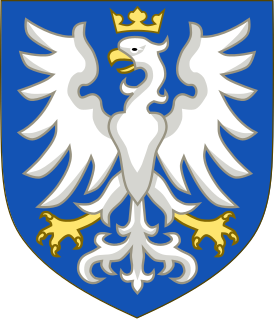
The House of Este is an Italian dynasty that has links with several royal families, including the House of Habsburg-Lorraine and the British royal family.

Alfonso d'Este was Duke of Ferrara during the time of the War of the League of Cambrai.
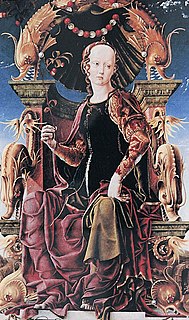
Cosmê Tura, also known as Il Cosmè or Cosimo Tura, was an Italian early-Renaissance painter and considered one of the founders of the School of Ferrara.
The School of Ferrara was a group of painters which flourished in the Duchy of Ferrara during the Renaissance. Ferrara was ruled by the Este family, well known for its patronage of the arts. Patronage was extended with the ascent of Ercole d'Este I in 1470, and the family continued in power till Alfonso II, Ercole's great-grandson, died without an heir in 1597. The duchy was then occupied in succession by Papal and Austrian forces. The school evolved styles of painting that appeared to blend influences from Mantua, Venice, Lombardy, Bologna, and Florence.

Palazzo Schifanoia is a Renaissance palace in Ferrara, Emilia-Romagna (Italy) built for the Este family. The name "Schifanoia" is thought to originate from "schivar la noia" meaning literally to "escape from boredom" which describes accurately the original intention of the palazzo and the other villas in close proximity where the Este court relaxed. The highlights of its decorations are the allegorical frescoes with details in tempera by or after Francesco del Cossa and Cosmè Tura, executed ca 1469–70, a unique survival of their time.

The Duchy of Ferrara was a state in what is now northern Italy. It consisted of about 1,100 km2 south of the lower Po River, stretching to the valley of the lower Reno River, including the city of Ferrara. The territory that was part of the Duchy was ruled by the House of Este from 1146 to 1597.

The Castello Estense or castello di San Michele is a moated medieval castle in the center of Ferrara, northern Italy. It consists of a large block with four corner towers.
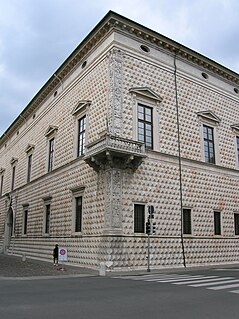
Palazzo dei Diamanti is a Renaissance palace located on Corso Ercole I d'Este 21 in Ferrara, region of Emilia Romagna, Italy. The main floor of the Palace houses the Pinacoteca Nazionale di Ferrara.

Ippolito (I) d'Este was an Italian Roman Catholic cardinal, and Archbishop of Esztergom. He was a member of the ducal House of Este of Ferrara, and was usually referred to as the Cardinal of Ferrara. Though a bishop of five separate dioceses, he was never consecrated a bishop. He spent much of his time supporting the ducal house of Ferrara and negotiating on their behalf with the Pope.
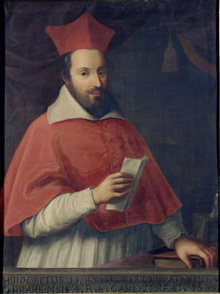
Ippolito (II) d'Este was an Italian cardinal and statesman. He was a member of the House of Este, and nephew of the other Ippolito d'Este, also a cardinal. He is perhaps best known for his despoliation of the then 1,400-year-old Hadrian's Villa, built by the Roman emperor Hadrian, removing marbles and statues from it to decorate his own villa, the Villa d'Este.
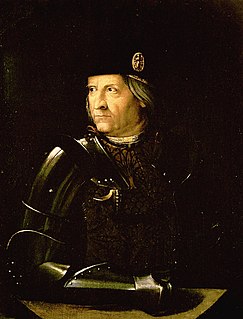
Ercole I d'Este KG was Duke of Ferrara from 1471 until 1505. He was a member of the House of Este. He was nicknamed North Wind and The Diamond.
Giulio d'Este was the illegitimate son of Ercole I d'Este, Duke of Ferrara. He is known for the conflicts he had with his half brother, Ippolito d'Este, which culminated in a failed conspiracy.

The Galleria Estense is an art gallery in the heart of Modena, centred around the collection of the d’Este family: rulers of Modena, Ferrara and Reggio from 1289 to 1796. Located on the top floor of the Palazzo dei Musei, on the St. Augustine square, the museum showcases a vast array of works ranging from fresco and oil painting to marble, polychrome and terracotta sculpture; musical instruments; numismatics; curios and decorative antiques.

Sigismondo d' Este was the youngest son of Ercole I d'Este, Duke of Ferrara, and Eleanor of Aragon, daughter of Ferdinand I of Naples.
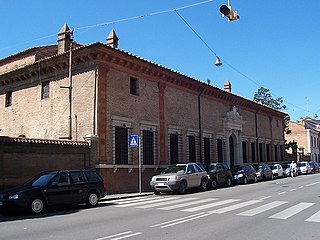
The Palazzina Marfisa d'Este is a Renaissance-style small palace, once suburban, and sometimes referred to as a villa, located on Corso Giovecca #170, just east of Central Ferrara, region of Emilia-Romagna, Italy. It was constructed in 1559 by the peripatetic Francesco d'Este, and inherited by his daughter, Marfisa in 1578.

Palazzo Prosperi-Sacrati is a Renaissance-style palace located on Corso Ercole I d'Este in Ferrara, region of Emilia Romagna, Italy. The palace with its protruding marble portal and balcony, and with a corner balcony and pilaster on the corner with Corso Biagio Rossetti, was designed and built in 1493-1498 by Biagio Rossetti as part of the Addizione Erculea. It is flanked on the ground floor by marble pilasters. It is across the Corso Rossetti from the lateral facade of the Palazzo dei Diamanti.

The Corpus Domini Monastery is a monastery at 4 via Pergolato in Ferrara. It first was founded as a house of penitent women, and became a Poor Clares Observant Franciscan convent in 1431. It was the home of Caterina Vigri from 1431-1456. She served as the mistress of novices, teaching about 100 women to become pious nuns. She was also an artist who illuminated her own breviary and is said to have decorated the walls of the convent with images of the Christ Child. These were lost or destroyed in a fire in 1667. The public church was redecorated in the late-Baroque period. On its high altar is Communion of the Apostles by Giambettino Cignaroli (1768), whilst the church's ceiling fresco Glory of Saint Catherina Vegri is by Giuseppe Ghedini (1770–1773). The house is still a monastery; a community of Franciscan nuns, called Poor Clares after S. Clare their founder and companion to S. Francis. One of their abbesses was the daughter of Lucrezia Borgia, Leonara d'Este. She is now recognised as one of the earliest writers of polyphonic choral music for women.

Ferrante d'Este was a Ferrarese nobleman and condottiero. He was the son of Ercole I d'Este and Eleonora d'Aragona - he was named after his mother's father Ferdinand I of Naples. His five siblings were Alfonso I d'Este, cardinal Ippolito d'Este, Isabella d'Este, wife of Francesco II Gonzaga, Beatrice d'Este, and Sigismondo d'Este. His two illegitimate half-siblings were Giulio and Lucrezia d'Este.

Marfisa d'Este was a Ferrarese noblewoman. She was the illegitimate daughter of Francesco d'Este and [Maria Folch de Cardona] .She and her sister Bradamante were legitimised by both pope Gregory XIII and Alfonso II d'Este. She was also notable as a patron of the arts and the protector of Torquato Tasso.